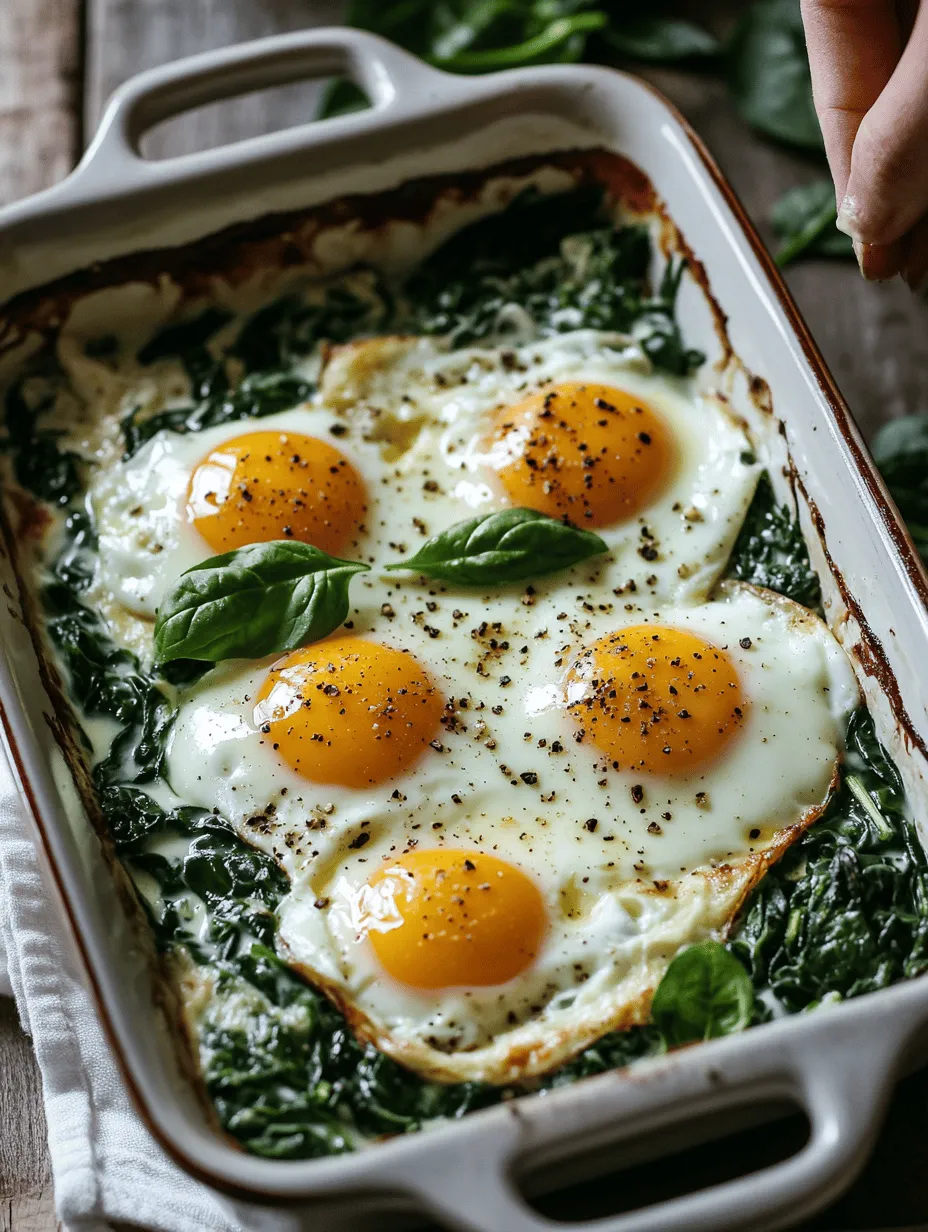The culinary world is filled with endless possibilities, and one dish that beautifully marries simplicity and elegance is Baked Eggs Florentine Delight. This delightful recipe features layers of fresh spinach, rich creamy cheeses, and perfectly baked eggs, making it an ideal choice for brunch or a cozy dinner. With its vibrant flavors and satisfying textures, this dish not only nourishes the body but also brings a sense of comfort to the table. In this article, we will explore the origins of Florentine cuisine, the health benefits of the ingredients used, and a step-by-step guide on how to create this exquisite dish.
Understanding the Florentine Cuisine
Historical Roots of Florentine Cuisine
Florentine cuisine, originating from Florence, Italy, is celebrated for its simplicity and heartwarming flavors. This culinary tradition emphasizes the use of fresh, local ingredients and straightforward cooking techniques that allow the natural flavors to shine through. Historically, Florentine dishes have been influenced by the region’s rich agricultural landscape, which provides an abundance of vegetables, grains, and dairy products. The famous “Cucina Povera,” or peasant cooking, is a hallmark of this tradition, showcasing recipes that were created out of necessity yet offer incredible taste and satisfaction.
One of the key ingredients often associated with Florentine cuisine is spinach. This leafy green vegetable has been cultivated in Italy for centuries and is a staple in many traditional dishes. The use of spinach in Italian cooking can be traced back to the Renaissance period, where it was favored for its vibrant color and nutritional benefits. It is often used in fillings, sauces, and, of course, as a base for baked dishes like our Baked Eggs Florentine Delight.
The Significance of Spinach in Italian Cooking
Spinach not only brings a burst of color and flavor to dishes but also offers numerous health benefits. It is packed with essential vitamins and minerals, including iron, calcium, and vitamins A, C, and K. Additionally, spinach is low in calories, making it an excellent choice for those looking to maintain a balanced diet. In the context of our Baked Eggs Florentine Delight, spinach serves as a nutrient-dense layer that complements the richness of the eggs and cheeses.
Influence of Local Ingredients on Traditional Recipes
Florentine cuisine heavily relies on local and seasonal ingredients, which enhances the freshness and flavor of the dishes. The use of high-quality dairy products, such as ricotta and Parmigiano-Reggiano cheese, is crucial in creating the creamy textures that define many Florentine recipes. In our Baked Eggs Florentine Delight, the combination of these cheeses not only adds richness but also contributes to the overall taste experience.
Key Ingredients in Baked Eggs Florentine Delight
The Role of Eggs as a Versatile Ingredient
Eggs are the star of Baked Eggs Florentine Delight, providing a source of protein and a luscious, creamy texture when baked to perfection. They are incredibly versatile and can be incorporated into a myriad of dishes, from breakfast to dinner. In this recipe, eggs are baked atop a bed of sautéed spinach and cheeses, resulting in a comforting and satisfying dish that can easily be customized to suit various tastes.
Nutritional Benefits of Spinach
As mentioned earlier, spinach is not only a flavorful addition to our recipe but also a powerhouse of nutrients. It supports eye health, aids in digestion, and may even help reduce oxidative stress. Incorporating spinach into your meals can promote overall health and wellness, making Baked Eggs Florentine Delight not just a treat for the taste buds but also a nourishing option for your body.
Importance of Dairy in Creating Creamy Textures
Dairy products play a vital role in achieving the creamy, indulgent texture of Baked Eggs Florentine Delight. Ricotta cheese adds a light, fluffy element, while Parmigiano-Reggiano cheese introduces a sharp, nutty flavor that elevates the dish. The combination of these cheeses creates a harmonious balance that enhances the overall taste and mouthfeel of the baked eggs.
Garlic as a Flavor Enhancer
Garlic is another essential ingredient in this recipe, providing a fragrant and savory depth of flavor. It complements the earthiness of the spinach and the richness of the eggs and cheeses, resulting in a well-rounded dish. Garlic is not only an aromatic powerhouse but also boasts a range of health benefits, including antimicrobial properties and potential heart health support.
The Recipe Breakdown
Ingredient List for Baked Eggs Florentine Delight
To prepare Baked Eggs Florentine Delight, gather the following ingredients:
– Fresh Spinach: Approximately 4 cups, washed and chopped. Look for vibrant, dark green leaves that are free from blemishes.
– Eggs: 4 large eggs. Organic or free-range eggs are ideal for the best flavor and nutritional profile.
– Ricotta Cheese: 1 cup. Choose a smooth, creamy ricotta for a delightful texture.
– Parmesan Cheese: ½ cup, grated. Freshly grated Parmesan will provide the best flavor.
– Garlic: 2 cloves, minced. Fresh garlic is preferred for its pungent flavor.
– Butter: 1 tablespoon for greasing the baking dish and adding richness.
– Salt and Pepper: To taste. Essential for enhancing the flavors of the dish.
Tips for Selecting Fresh Spinach and Quality Cheeses
When selecting spinach, aim for fresh, organic varieties whenever possible. Look for leaves that are crisp and vibrant, avoiding any that appear wilted or discolored. For the cheeses, opt for high-quality ricotta and Parmesan. Freshly grated cheese will not only taste better but also melt more smoothly, contributing to the overall creaminess of the dish.
Variations Based on Dietary Preferences
One of the beautiful aspects of Baked Eggs Florentine Delight is its versatility. For those with dietary restrictions, consider these adaptations:
– Dairy-Free Option: Substitute ricotta with a plant-based cheese alternative, such as cashew or tofu-based ricotta, and use nutritional yeast in place of Parmesan for a cheesy flavor.
– Vegan Version: Use a chickpea flour mixture or silken tofu blended with nutritional yeast as an egg substitute, and ensure your cheese replacements are entirely plant-based.
– Gluten-Free: This recipe is naturally gluten-free as it does not contain any bread or flour. However, always verify that any added ingredients, such as cheeses or seasonings, are also gluten-free.
Preparation Steps for Perfect Baked Eggs
Creating the perfect Baked Eggs Florentine Delight begins with careful preparation. Follow these steps to ensure your dish turns out beautifully:
Preheating the Oven: Why Temperature Matters
Preheat your oven to 375°F (190°C). Preheating is crucial as it allows for even cooking and helps the eggs set properly. A well-heated oven ensures that the dish bakes uniformly, resulting in tender yet firm eggs that hold their shape.
Buttering the Baking Dish: Techniques for Even Coverage
While the oven is preheating, prepare your baking dish by generously buttering the bottom and sides. This step not only prevents the dish from sticking but also adds a layer of flavor. Use a paper towel or your fingers to spread the butter evenly, ensuring every inch of the dish is coated. This technique will help the eggs and spinach release easily once baked.
Layering the Spinach: Importance of Even Distribution
Next, layer the chopped spinach in the greased baking dish. Sauté the spinach in a pan with minced garlic until wilted and fragrant, about 2-3 minutes. This step enhances the flavor and reduces excess moisture, preventing your dish from becoming watery. Once wilted, spread the spinach evenly in the baking dish, creating a solid base for the eggs and cheeses.
As you continue with the preparation of Baked Eggs Florentine Delight, keep in mind that the layering of ingredients is essential for achieving the perfect balance of flavors. Each element plays a crucial role in creating a dish that is not only delicious but also visually appealing. In the following sections, we will delve deeper into assembling the dish, baking techniques, and serving suggestions that will elevate your Baked Eggs Florentine Delight to new heights.
Stay tuned for the next part, where we will complete this recipe with the final assembly steps and tips for serving this delightful dish!

Creating the Creamy Mixture: Tips for Achieving the Right Consistency
The creamy base of your Baked Eggs Florentine Delight is pivotal in ensuring that the dish is rich and satisfying without overshadowing the delicate flavors of the spinach and eggs. To achieve the right consistency, start by combining your dairy ingredients: heavy cream, milk, or a non-dairy alternative, along with your chosen cheese, such as ricotta or cream cheese.
1. Whisking Technique: Use a whisk to blend the ingredients smoothly. This helps to incorporate air, creating a light and fluffy mixture. If using cream cheese, ensure it is at room temperature to avoid lumps.
2. Thickness Control: If you prefer a thicker creamy layer, whisk in a tablespoon of flour or cornstarch. This will help stabilize the mixture during baking and maintain a luscious texture.
3. Flavor Enhancements: Consider adding a pinch of nutmeg or a squeeze of lemon juice to enhance the flavor profile. Nutmeg complements the creaminess beautifully, while lemon adds a refreshing note that cuts through the richness.
Cracking the Eggs: Techniques for Perfect Egg Placement
When it comes to eggs, precision is key. Cracking them into your creamy mixture requires a gentle touch to prevent any shell fragments from ruining your dish.
1. Cracking Method: Hold the egg firmly but not too tightly, and crack it against a flat surface, such as your countertop, rather than the edge of a bowl. This technique minimizes the chance of shell pieces breaking off into the egg.
2. Placement: After cracking, gently slide the egg into the baking dish, ensuring each yolk is nestled in the creamy mixture without breaking. If you’re preparing multiple servings, create small wells in the mixture to guide the eggs into place.
3. Preventing Spills: Another effective technique is to crack the eggs into a separate bowl first. This allows you to inspect for any shell fragments and ensures smoother placement into the baking dish.
Seasoning: Balancing Flavors for the Best Taste
Seasoning is an essential step that elevates your Baked Eggs Florentine Delight from simple to exceptional. With the richness of eggs and cream, it’s important to balance flavors to achieve a harmonious dish.
1. Salt and Pepper: Start with a base of salt and freshly cracked black pepper. These staples enhance the inherent flavors of your ingredients. Be mindful of the cheese’s saltiness; taste as you go.
2. Herbs and Spices: Fresh herbs such as thyme, parsley, or even chives can add a burst of freshness. Dried herbs can be used as well, but remember that they are more concentrated, so adjust accordingly.
3. Garlic: Finely minced garlic will infuse the dish with flavor. Sauté it lightly in olive oil or butter before adding to your creamy mixture if you prefer a milder, sweeter garlic flavor.
Baking Process
The Importance of Baking Time and Temperature
Baking is where the magic happens, transforming your carefully layered ingredients into a cohesive and delightful dish. Preheat your oven to 350°F (175°C) to ensure even cooking.
1. Temperature Considerations: Baking at a moderate temperature allows for the eggs to cook gently, preventing them from becoming rubbery. A hot oven can lead to overcooked edges while leaving the center underdone.
2. Texture Transformation: As you bake, the eggs will set, and the creamy mixture will bubble slightly, creating a delightful texture. The goal is a custardy interior with a slightly firmer exterior.
Tips for Checking Egg Doneness: Soft vs. Firm Yolks
Understanding how to check for doneness is vital to achieving your desired texture.
1. Soft Yolks: For a creamier, runny yolk, bake for about 12-15 minutes. The whites should be fully set, while the yolk remains soft and slightly jiggly.
2. Firm Yolks: If you prefer a firmer yolk, extend the baking time to 15-20 minutes. The yolk will be fully cooked, while the whites remain tender.
3. Visual Cues: Look for the creamy mixture to be bubbly around the edges and the eggs to have a slight sheen. A toothpick test can also be helpful: insert it into the creamy layer; it should come out clean or with minimal residue for fully set eggs.
Adjusting Baking Times Based on Oven Differences
Remember that every oven is unique; some may run hotter or cooler than others.
1. Oven Thermometer: Invest in an oven thermometer to verify your oven’s accuracy. This simple tool can save you from overcooking or undercooking your dish.
2. Adjust Accordingly: If your oven runs hot, reduce the temperature slightly or decrease baking time. Conversely, if it runs cool, extend the cooking time by a few minutes while keeping a close eye on the dish.
Serving Suggestions
Plating the Baked Eggs Florentine Delight
Presentation is key to making your dish visually appealing.
1. Garnishing: Top your baked eggs with freshly chopped herbs or a sprinkle of paprika for a pop of color. A drizzle of olive oil can add a touch of richness and shine.
2. Serving Style: Serve directly from the baking dish for a rustic feel, or spoon portions onto individual plates for a more refined presentation.
Suggested Side Dishes and Beverages that Pair Well
Baked Eggs Florentine Delight can be complemented beautifully by a variety of sides and drinks.
1. Side Dishes: A simple green salad with a lemon vinaigrette balances the richness of the dish. Sautéed asparagus or roasted tomatoes make excellent accompaniments, adding color and flavor.
2. Beverages: Pair your dish with a crisp white wine, such as Sauvignon Blanc, or a refreshing mimosa for a brunch setting. For non-alcoholic options, a herbal tea or fresh juice works wonderfully.
Seasonal Variations to Enhance the Dish Throughout the Year
One of the beauties of Baked Eggs Florentine Delight is its adaptability. Consider these seasonal variations:
1. Spring: Incorporate fresh herbs like dill or tarragon and add peas for a pop of sweetness.
2. Summer: Use ripe tomatoes and zucchini for a garden-inspired twist.
3. Fall: Add roasted butternut squash and sage for a warm, comforting flavor.
4. Winter: Introduce kale instead of spinach for a heartier dish, and consider adding a touch of nutmeg for warmth.
Health Benefits of Baked Eggs Florentine Delight
Nutritional Overview of Key Ingredients
Baked Eggs Florentine Delight is not just delicious; it’s packed with essential nutrients that contribute to a balanced diet.
1. Eggs: Eggs are a fantastic source of high-quality protein, providing all the essential amino acids your body needs. They are also rich in vitamins such as B12, which is crucial for energy metabolism.
2. Spinach: Spinach is a leafy green powerhouse, packed with vitamins A, C, and K, as well as iron and calcium. Its high antioxidant content supports overall health and helps combat oxidative stress.
3. Dairy: Using dairy products like cheese and cream adds calcium, which is vital for bone health. Choose low-fat options if you’re looking to reduce calorie intake without sacrificing flavor.
4. Garlic: Beyond its flavor, garlic has numerous health benefits. It is known to support heart health, boost the immune system, and may even have anti-inflammatory properties.
Conclusion
Baked Eggs Florentine Delight is not just a meal; it’s an experience that reflects the beauty of simple ingredients coming together harmoniously. Embracing the essence of Florentine cuisine, this dish offers a delightful blend of flavors and textures that can be enjoyed any time of the day. Whether you are entertaining guests or treating yourself to a comforting meal, this recipe is sure to impress and satisfy. As you explore this delightful dish, consider the rich history and health benefits that make it a staple worthy of any kitchen. Enjoy the journey of creating and savoring your Baked Eggs Florentine Delight!


